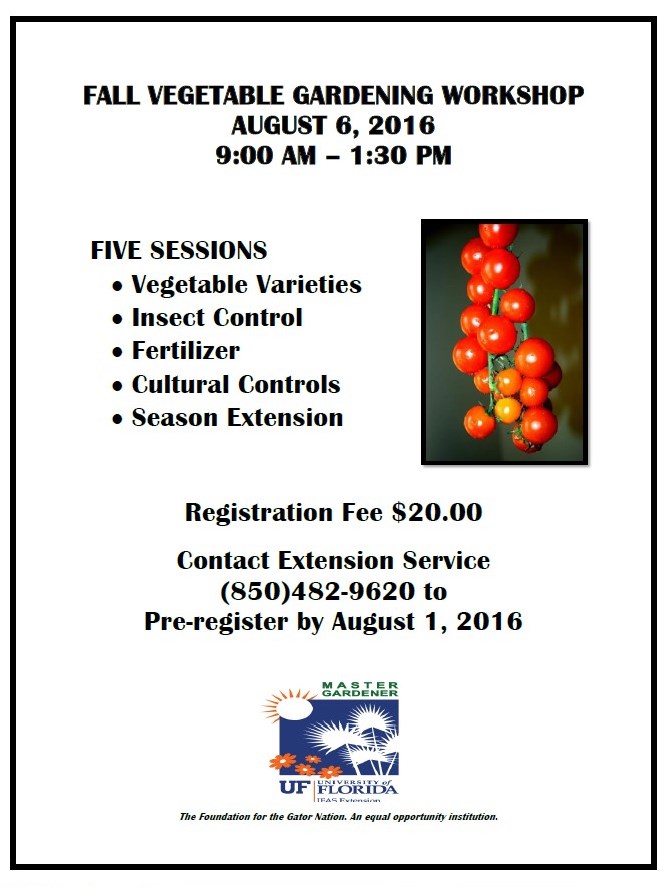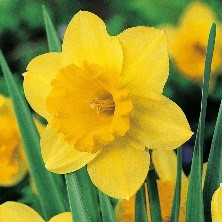
by Matt Lollar | Oct 28, 2016

The Jackson County Master Gardeners are selling daffodil bulbs. Bulbs are sold in paper bags for $5.00 per bag. Bulb counts vary per bag based on bulb size. For descriptions of available bulbs please see the attached flyer.
Jackson County Daffodil Selection/Description
To make a bulb order or for other questions please call the Jackson County Extension Office at (850)482-9620 and asked for Ms. Doris or Mr. Carl.
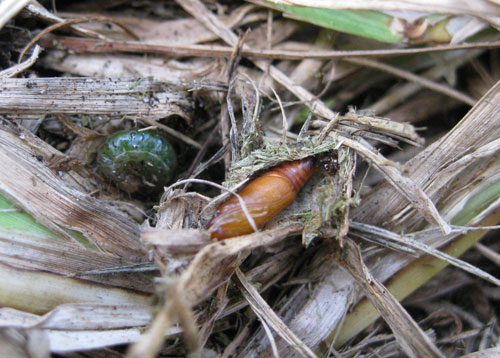
by Matt Lollar | Sep 29, 2016
Tropical sod webworms (Herpetogramma phaeopteralis) have recently been encountered in a number of yards in the Panhandle. The worms usually feed in large groups and unfortunately, the first, and basically the only, sign of damage is often a large area of shorter grass due to their feeding. The arrival time of sod webworms is also unfortunate because they are part of a group of caterpillars that successively attack turf including fall armyworm (Spodoptera frugiperda), striped grass loopers (Mocisspp.), and the fiery skipper (Hylephila phyleus).
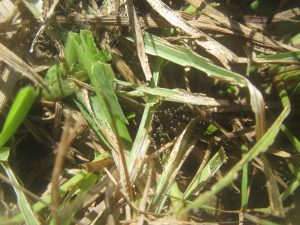
Sod webworm feeding damage in the turf thatch layer. Photo Credit: University of Florida/IFAS Extension.
Description
Larvae
Caterpillars are light yellow to orange with brown spots on each body segment and they have a dark, orange-brown head. They will grow to a full length of slight less than 1/2 inch.
Pupae
The reddish brown pupae are about about 1/4 inch long. The pupae are typically found in the upper thatch layer.
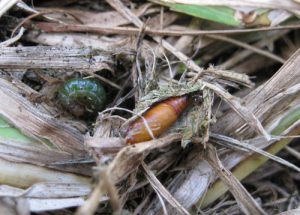
Pupa found in cocoon in St. Augustinegrass thatch. Photo Credit: Steven Arthurs, University of Florida/IFAS
Adults
The moths brown with splotchy wings and are about 3/4 inch wide.
Control
Sod webworms are difficult to control because of their spontaneity. However, in the lawn they hide in the thatch during the heat of the day. Over watering and fertilization can increase the amount of thatch. It is important to follow UF/IFAS guidelines for home lawn management.
The first line of defence is healthy turf. Proper fertilization, irrigation, and mowing height can decrease susceptibility of turfgrass against sod webworm. Over-fertilization is a common cause of caterpillar outbreaks in lawns. Cultural practices such as thatch removal by vertical mowing can help eliminate populations. Eggs are laid on grass blades and removal of grass clippings might also reduce populations.
Numerous chemical control options are available, but softer chemicals such as insecticides containing the bacteria Bacillus thuringiensis are recommended as a first line of defense. Insecticides should be applied in the morning or evening during feeding time. For additional control strategies and basic information please visit the UF/IFAS Sod Webworm Publication.

by Matt Lollar | Sep 8, 2016
Plants can become distorted for a wide variety of reasons. Sometimes nutrient deficiencies or toxicities can cause plants to become distorted. Sometimes excessive amounts of water or sunlight can cause plants to become distorted. And sometimes insect feeding damage can be the culprit.
Insects can cause plant mutations by feeding alone or by vectoring disease from one plant to another. The most recent and most detrimental example of insects vectoring disease is the Asian Citrus Psyllid, which has distributed Huanglongbing, also known as citrus greening, to most of the citrus acreage in Florida and across the United States. Fortunately, the panhandle is currently free from this detrimental disorder. However, we still have a plethora of insects that distort plants by one way or another. One group of plant altering insects are commonly known as planthoppers.
Planthopper adults range in size between 1/8 to 1/4 inches long. They are slender and frequently have an angular, pointed head. Coloration depends on species, but generally planthoppers are of green, brown, or white. Immatures look similar to the adults except they are smaller and don’t have wings. Immatures typically feed on the underside of leaves, where the humidity is higher and they are more protected from predators.

Three growth stages of planthoppers. Photo Credit: UF/IFAS Extension
Planthoppers feed on plant leaves and shoots by sucking out the contents. The damage that ensues from feeding depends on the host plant and the hopper species. A few species of hoppers transmit pathogens that can alter plant growth. Usually, adult hoppers are pests only when found in high numbers.
Feeding damage from some species causes small white spots (stippling) to appear on the upper leaf surface, usually beginning near the leaf midrib. Stippled areas eventually merge together into larger whitish blotches. In some plants, feeding damage causes a drying and yellowing (or browning) of leaf tips and some planthopper species cause curling or stunting of newly formed leaves. Oftentimes, white, papery skin castings will remain from the molting process on the undersides of leaves.
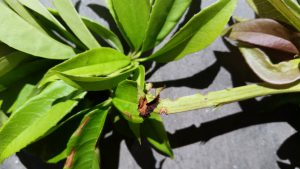
Planthopper feeding damage on sweet olive. Photo Credit: UF/IFAS Extension
Planthoppers are rarely present in large enough numbers to cause significant plant damage. Fortunately, planthoppers have many natural enemies including lady beetles, lacewings, damsel bugs, and spiders. Sticky traps are recommended to help monitor planthopper populations. Planthoppers are usually attracted to yellow sticky traps that can be placed among the plant leaves. Small populations can be managed using these traps. If greater populations are present, then insecticidal soap can control young planthoppers. Make sure to spray both the top and underside of the leaves.
Planthoppers are minor pests in the landscape, but they can cause alarming mutations in plant material. Contact your local Extension Office for help with diagnosis and treatment options.
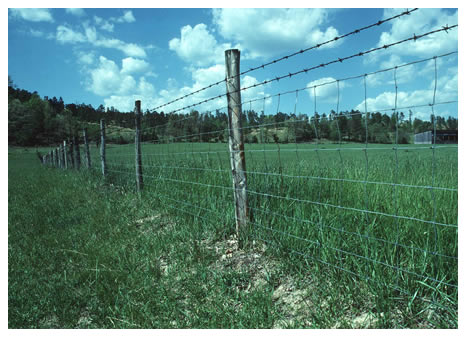
by Matt Lollar | Jul 26, 2016
Nothing looks better than a fence clean from weeds right? It all depends on the goal you have in mind. If you want to one day receive the infamous honor of “yard of the month”, than you might want the cleanest and straightest fence around. If you have goals of providing a habitat for wildlife and beneficial insects, some selective strategies need to be implemented. Providing a habitat for beneficials can easily be achieved through minimal maintenance and selective plant removal.
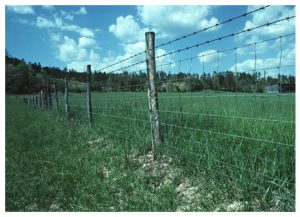
A typical clean fence row. Photo Credit: Iowa State University Extension
If you are starting with a clean fence free of herbaceous plants, shrubs, vines, and trees then you have two options: Replant vegetation for the ideal habitat(1) or allow for natural plant succession to take its course(2). If you chose option 2, that’s it, you’re done. However, if you chose option 1 then you begin the search of garden centers for desirable plants.
In order to pick the best plants, you will need to think about what you want to attract. Do you want to attract vertebrates, invertebrates, or a little of both? Vertebrates are attracted to plants that provide shelter and food. A good start for selecting plants would be to read the publication “Native Plants That Benefit Native Wildlife in the Florida Panhandle”.
As you already know, pollinator insects are attracted to nectar and pollen. However, beneficial insects cannot survive on just eating bad bugs and they need supplemental nutrition. They receive this supplemental nutrition by way of extrafloral nectaries. Extrafloral nectaries are nectar-producing glands located on plant parts other than the flowers. They can be located on plant leaves, stems, or fruit. A list of plants containing extrafloral nectaries can be found in the publication “Many Plants Have Extrafloral Nectaries Helpful to Beneficials”.
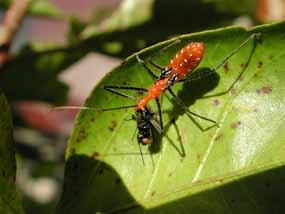
A milkweed assassin bug. Photo Credit: Texas A&M University.
Although it’s great idea to attract wildlife to your fencerows, it is important to choose plant material based on your fence’s location in vicinity to your house. Fire can easily jump from plant material to fences to your house. The Firewise Communities Guidelines should be followed for landscaping your home.











